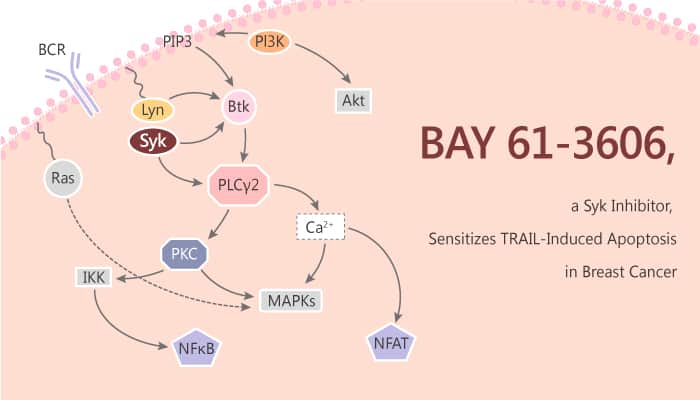Breast cancer cells usually develop resistance to tumor necrosis factor-related apoptosis-inducing ligand (TRAIL). TRAIL shows cancer-selective killing activity. TRAIL ligand selectively kills cancer cells by initiating apoptotic signaling through the engagement of its pro-apoptotic receptors, death receptors-4 and -5. In particular, myeloid cell leukemia sequence-1 (Mcl-1) is a member of the anti-apoptotic Bcl-2 family proteins. As a result, knockdown of Mcl-1 gene enhances TRAIL-induced apoptotic. Moreover, spleen tyrosine kinase (Syk) inhibitor BAY 61-3606 is a TRAIL sensitizer. Bay 61–3606 amplifies TRAIL-induced apoptosis. This effect accompanies the strong activation of Bak, caspases, and DNA fragmentation.

In the mechanism of action, Bay 61–3606 sensitizes cells to TRAIL via two mechanisms regulating Mcl-1. Firstly, Bay 61–3606 induces ubiquitin-dependent degradation of Mcl-1 by regulating Mcl-1 phosphorylation at Ser159. Secondly, Bay 61–3606 downregulates Mcl-1 expression at the transcription level. Furthermore, Bay 61–3606 inhibits Mcl-1 gene transcription by inhibiting CDK9-mediated RNA pol II activity. In this study, So-Young Kim, et al have identified Bay 61–3606 as a new TRAIL sensitizer in MCF-7 breast carcinoma cells. Bay 61–3606 sensitizes MCF-7 cells to TRAIL by decreasing Mcl-1. Bay 61-3606 is a spleen tyrosine kinase (Syk) inhibitor. On the contrary, Bay 61–3606 induces Mcl-1 downregulation in a Syk-independent manner. In addition, Bay 61–3606 induced ubiquitin-dependent degradation of Mcl-1 by ERK inactivation. Consistently, Bay 61–3606 promotes the ubiquitin/proteasome-dependent degradation of the Mcl-1 protein in MCF-7 Cells. In addition, combination treatment with Bay 61–3606 and TRAIL suppresses tumor growth in vivo.
In conclusion, Bay 61–3606 is a promising agent for downregulating Mcl-1 expression in cancer cells. Bay 61-3606 sensitizes TRAIL-induced apoptosis in Breast Cancer Cells.